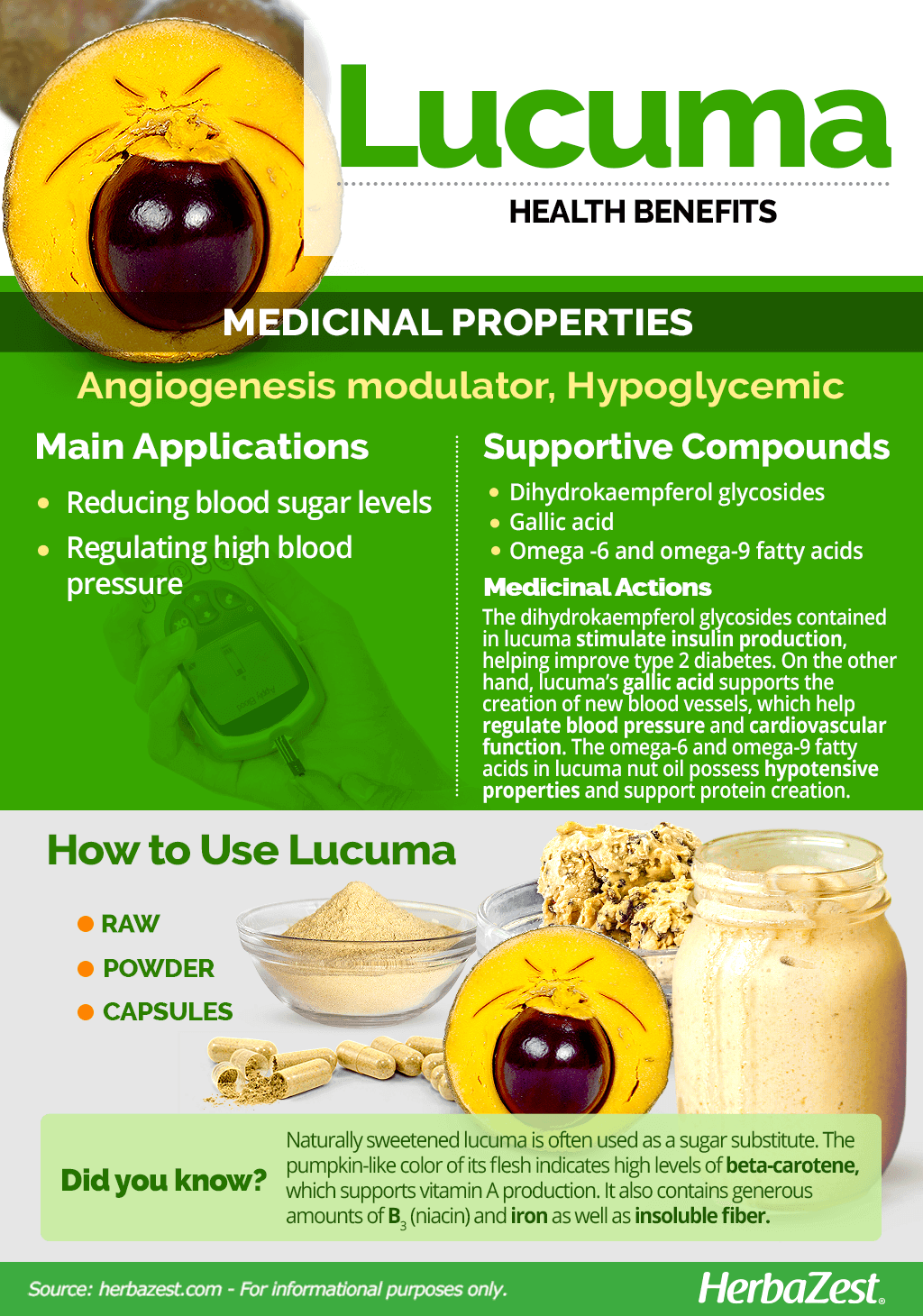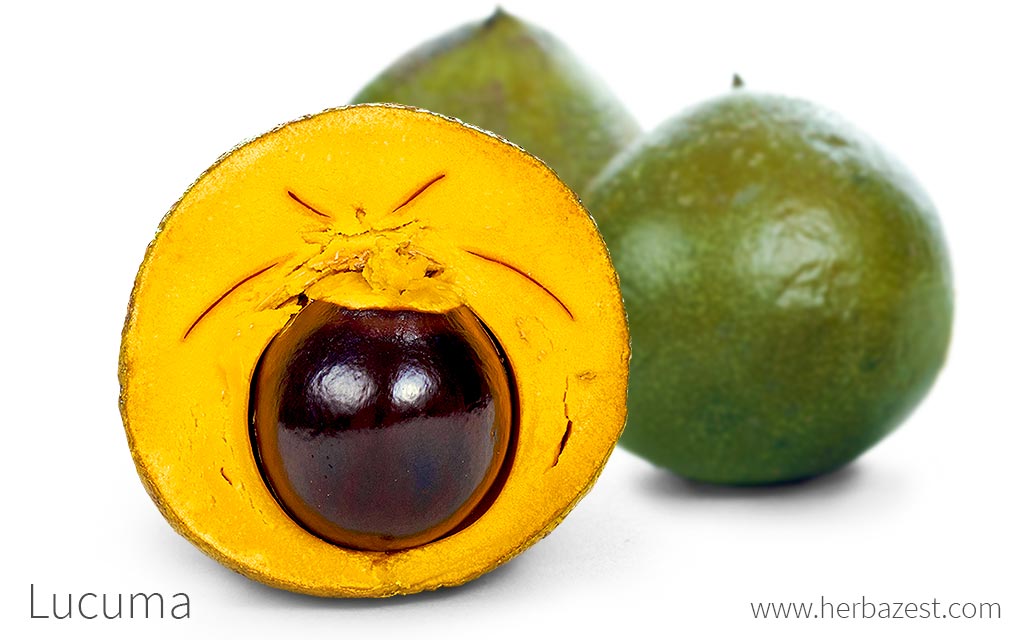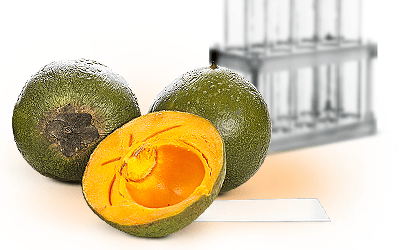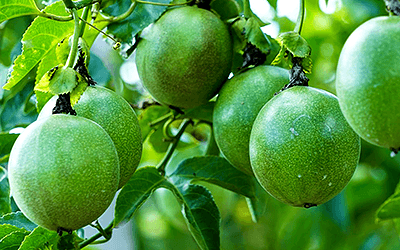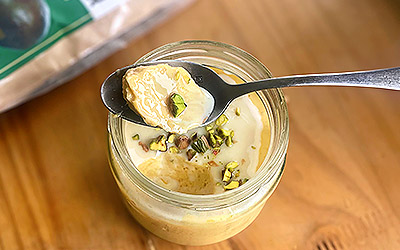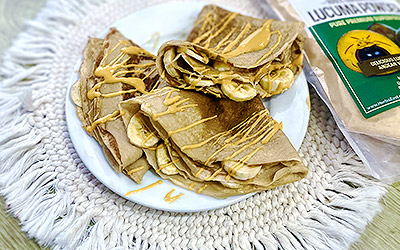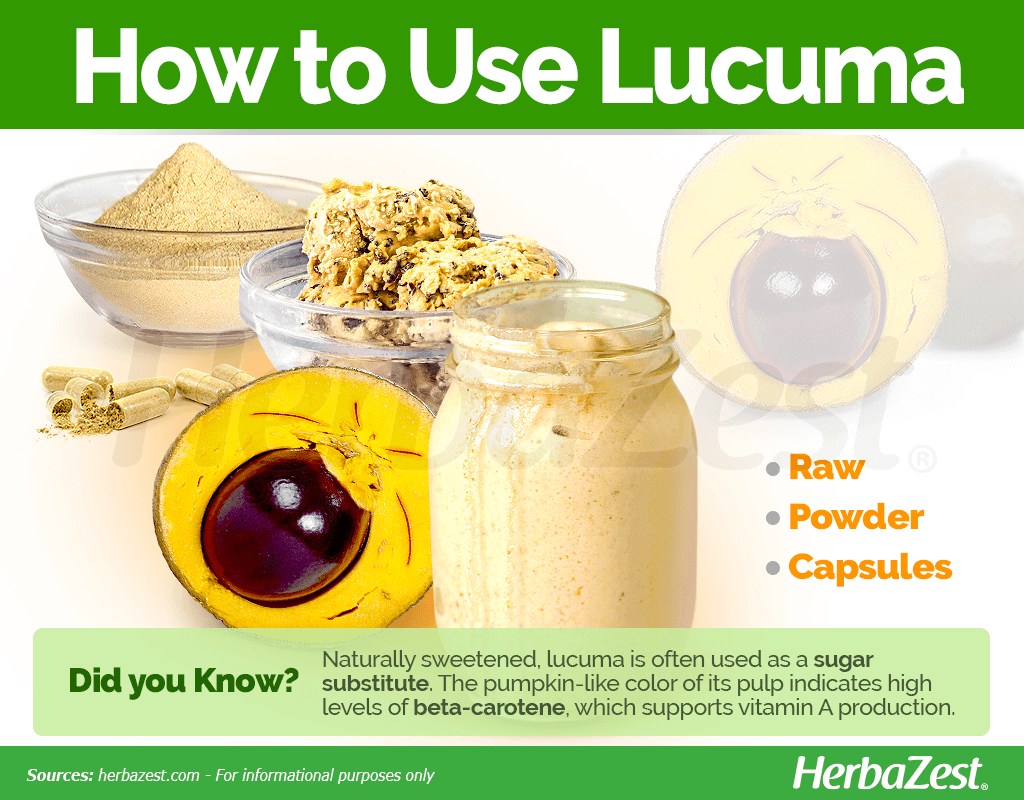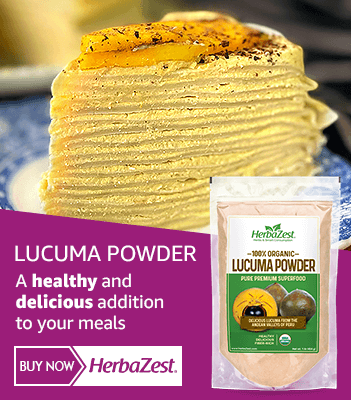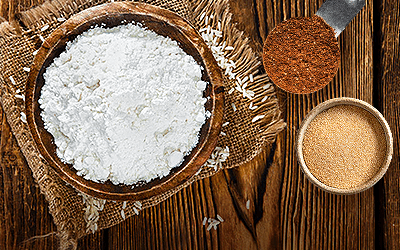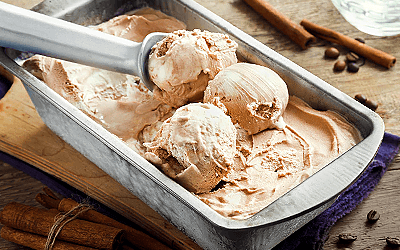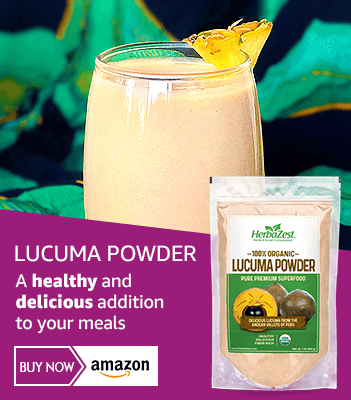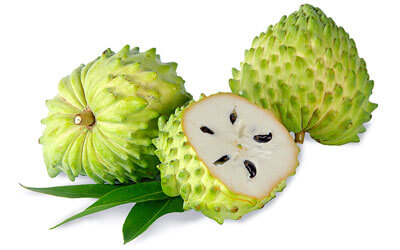Native to the temperate highlands of Ecuador and Peru, lucuma, also known as 'lucma', has not strayed far in modern times from its original Andean lands, where it has been a staple food and favorite fruit for over 2,000 years. Not considered a tropical plant, it has successfully grown in other temperate conditions up through Central America and part of Mexico.
Lucuma Medicinal Properties
Health Benefits of Lucuma
Although lucuma is yet to catch on with the rest of the world, and research on this South American fruit still scarce, studies have shed some light on its nutritional and medicinal properties. So far, lucuma has revealed health benefits that include:
Reducing blood sugar levels. In spite of its delicate sweetness, lucuma is not only low in sugar content, but also helps control glucose levels in people with diabetes.
Regulating high blood pressure. Studies have shown that lucuma helps treating hypertension, thus reducing the risk of cardiovascular diseases.
Additionally, preliminary studies have suggested that the essential oil obtained from the lucuma nut promotes wound healing and skin regeneration, and it may have potential nutraceutical and cosmetic applications.
In its native areas, lucuma have been traditionally used for promoting lactation on women after giving birth; however, there is very little scientific evidence corroborating this claim.
THANKS TO ITS LOW GLYCEMIC INDEX AND HIGH AMOUNTS OF DIETARY FIBER, LUCUMA IS A GREAT OPTION FOR DIABETICS.
How It Works
Lucuma is particularly rich in polyphenolic compounds, which have powerful anti-aging, anti-inflammatory, and antioxidant actions. Thanks to this high antioxidant content, the lucuma fruit may help reduce the incidence of diabetes, cardiovascular diseases, as well as other chronic health conditions.
The dihydrokaempferol glycosides contained in lucuma are important flavonoid compounds with anti-inflammatory activity, which play a role in the wound healing and skin-restorative benefits of the fruit. This compound has also been reported to stimulate insulin, which regulates glucose metabolism, thus helping improve conditions in type 2 diabetes.
On the other hand, lucuma also possess gallic acid, which stimulates the creation of new blood vessels, helps regulate blood pressure, and it is instrumental for cardiovascular function.
The agreeable sweetness and subtle flavor of the lucuma fruit are due to a combination of sugars, namely glucose, fructose, sucrose, and inositol. Inositol, in particular, is a glycoside that plays a crucial role in the metabolic actions of insulin, thus helping regulate glucose levels in the human body.
Additionally, the lucuma nut oil possesses omega-6 and omega-9 fatty acids, which have hypotensive properties and help in protein creation. These two main active acids in the oil provide therapeutic abilities that can alleviate itching and drying, which are two major symptoms of many skin conditions.
While the lucuma fruit contains the majority of nutrients, and it is the main usable part of the plant, the essential oil extracted from the seeds of lucuma is used for medicinal and cosmetic purposes.
Other herbs with hypotensive properties are bilberry, passion fruit, saffron, and stevia; whereas chia and yacon also help regulate blood sugar levels.
Lucuma Side Effects
There is little research available to determine the safety of lucuma use over a long period of time. As with any substance, caution should be taken when consuming lucuma in large portions consistently. Consult with a health professional about lucuma use if also regularly taking antihypertensive medications or other herbal supplements, because lucuma could potentially interact with their use.
- Medicinal action Cardioprotective, Hypoglycemic
- Key constituents Dihydrokaempferol glycosides, gallic acid, glucose, fructose, sucrose, and inositol
- Ways to use Capsules, Food, Juiced, Powder
- Medicinal rating (2) Minorly useful plant
- Safety ranking Safe
Lucuma Nutrition
In its fresh, raw form, lucuma is an excellent source of plant-based protein, important for muscle building and energy production, and also provides more than a half of the daily value for dietary fiber, which in this case is mainly insoluble, making lucuma a great fruit for treating digestive issues, such as constipation, as well as for preventing sugar spikes after meals, thus producing an hypoglicemic effect.
The nutritional value of the lucuma fruit is rounded by good amounts of vitamins B2 (riboflavin) and B3 (niacin), along with small quantities of other nutrients, such as calcium, iron, and phosphorus, as well as vitamins B1 (thiamin) and C (ascorbic acid).
Interestingly, the pumpkin-like color of lucuma's pulp indicates a high content of beta-carotene, which is a precursor of vitamin A, crucial for skin and eye health.
In addition, the Andean lucuma has a very low caloric value, which makes it a good sugar substitute to be included in weight-loss diets and consumed by people with hyperglycemia or diabetes.
100 grams of fresh lucuma pulp provide 99 calories, as well as 30% and 52% of the daily value for protein and dietary fiber, respectively.
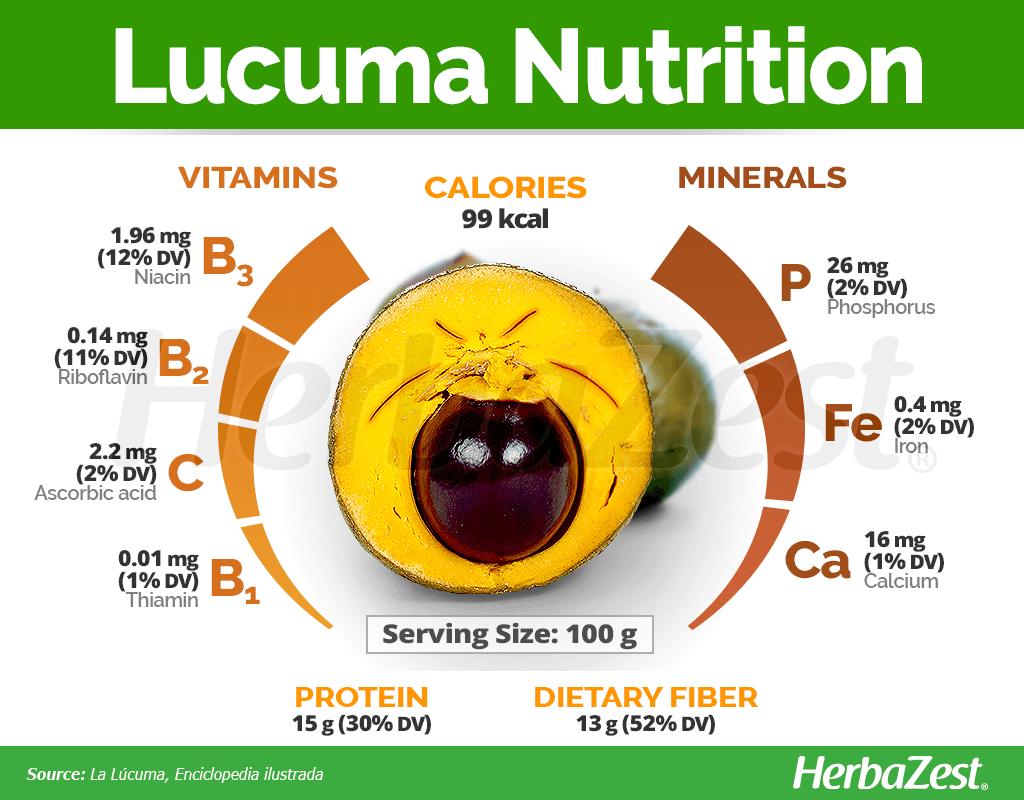
How to Consume Lucuma
Overwhelmingly popular as a food product in its native regions, lucuma is widely consumed in both fresh and dried forms. Its taste is considered initially appealing and can be described as sweet, like caramel, with a pumpkin-like texture that melts in one's mouth.
The lucuma fruit is widely used in South American desserts, and it is arguably more popular than chocolate among Peruvian ice cream flavors.
Natural Forms
Raw. The lucuma fruit can be eaten on its own; however its dry texture is unappealing to many people, and its pulp is more commonly consumed in smoothies and sweet recipes.
Powder. This is the most common form of lucuma outside of its native region, and it is especially popular for balancing blood pressure and stabilizing glucose levels. It is popularly used for desserts and baked goods.
While lucuma pulp and powder have a mildly sweet flavor, lucuma can't be considered as a sugar substitute.
Herbal Remedies & Supplements
Capsules. For those trying to regulate their blood sugar and reduce stress, lucuma capsules comes handy, in a convenient daily dose of antioxidants and fiber, which also aids with constipation.
- Edible parts Fruit
- Edible uses Flavoring, Beverage
- Taste Sweet
Growing
Unlike many other plants in its native lands, lucuma does not require a tropical climate. It grows successfully in Andean valleys and subtropical areas, at altitudes up to 10,000 feet (3,000 m) above sea level and temperatures as low as 41 °F (5 °C), with any temperatures below this resulting in plant death. Dry locations with sandy, slightly acidic soil and full sun are preferred, though it can also tolerate salty soil. It can grow in U.S. hardiness zones 9 - 12, though it is more susceptible to pests and diseases, like leaf spot, when cultivated at such latitudes.
Useful advice for growing lucuma can be found in the herb garden.
- Life cycle Perennial
- Harvested parts Fruit
- Light requirements Full sun
- Soil Light (sandy), Well-drained
- Soil pH 6.1 – 6.5 (Slightly acidic), 6.6 – 7.3 (Neutral)
- Growing habitat Cool temperate regions, Mountain regions, Subtropical regions, Andean region
- USDA Plant Hardiness Zones 11a, 11b, 12a, 12b
- Propagation techniques Cuttings
- Potential diseases Leaf spot
Additional Information
Plant Biology
A perennial evergreen, the lucuma tree grows best in temperate, mountainous climates like those of its native Andean highlands in Ecuador and Peru. Its height ranges from 25 - 50 feet (8 - 15 m), and it is identifiable by its clusters of dense crown of leathery, elliptical leaves at the ends of its small, downy branchlets. It blooms yearlong, producing yellow-green flowers with hairy sepals, from a brownish-green fleshy fruit containing latex-laden pulp is produced.
Classification
Lucuma (Pouteria lucuma, also known as Pouteria obovata, or Lucuma obovata) belong to the Sapotaceae family, which encompasses about 1,250 species of evergreen trees and shrubs across 53 genera widely distributed around the world, mainly in the tropical and subtropical regions of Asia and South America. Once classified as a genus, and still part of an ongoing controversy among taxonomists, the lucuma tree is now widely considered as a member of the genus Pouteria, which includes 325 species, many of them of great economic value as sources of high-quality timber and edible fruit.
Related Species, Varieties, and Cultivars of Lucuma
Well known relatives of lucuma are P. caimito (caimito, indigenous to Colombia and Brazil), and P. campechiana (canistel, native to Central America and tropical areas of Mexico). There are two main cultivars of the fruit that tend to have different functions: 'lúcuma de seda' has a high concentration of water and is preferred for fresh consumption, whereas 'lúcuma de palo' is drier, often utilized in making desserts such as ice cream and mousse. It is thought that there are more natural varieties of lucuma yet to be discovered or catalogued, which hold the potential for emerging lucuma markets from Venezuela, Chile, and Argentina.
Both the lucuma fruit and the canistel, its close relative, are often known by the common name of 'egg fruit', in reference to the bright-yellow color and pasty consistency of their pulp.
Historical Information
Long before its discovery by Western colonizers, lucuma was an integral part of indigenous diets for thousands of years.
It is now one of the national symbols of Peru, where 26 villages are named after the fruit.
Often called "the gold of the Incas," lucuma dates back many centuries with the first evidence found in images in archaeological sites around 200 CE. The ancient, pre-Incan Moche people were the first to cultivate it as a food source, a practice that spread throughout the region. Lucuma consumption spread beyond the region in 1531 when it was introduced to Europeans, and became very popular with the Spanish colonies in Central America and Chile.
Today, it is hugely popular in its original locations of Ecuador and Peru, but is still slowly gaining recognition outside of them. It has successfully grown in other temperate conditions up through Central America and part of Mexico, but its fruit has not enjoyed particular popularity in those locations.
Economic Data
Until very recent years, lucuma has found little worldwide demand as a commodity, though its popularity continues to steadily grow. South American countries represent both the biggest market and biggest producers of the plant, centrally focused around Peru. In 2009 alone, the country exported over 12 tons of the fruit, at an estimated FOB of more than $126,000 USD - the majority of the world's supply. This does not take domestic sales into account, which are significantly higher. Cultivation also occurs in Chile and, to a certain extent, in Ecuador and Bolivia, mainly focused on food product manufacturing.
The lucuma fruit serves as a cultural symbol in its native regions, and it is considered as a "flagship product" for Peruvians to represent their rich historical heritage.
Other Uses
Timber. The lucuma tree has a compact, durable wood that is used as building material, particularly in the areas where it grows in abundance.
Personal care. The fruit, particularly the lucuma seed, has potential within the cosmetics industry due to its ability to heal damaged skin.
- Other uses Cosmetics, Furniture/carpentry, Timber
Sources
- Applied and Environmental Microbiology, Production of 7-O-Methyl Aromadendrin, a Medicinally Valuable Flavonoid, in Escherichia coli, 2011
- Brazilian Journal of Pharmacognosy, Genus Pouteria: Chemistry and biological activity, 2009
- Exotic Fruits and Nuts of the New World, pp. 117-123
- Food Chemistry, Characterization of main primary and secondary metabolites and in vitro antioxidant and antihyperglycemic properties in the mesocarp of three biotypes of Pouteria lucuma, 2016
- Fruits of Warm Climates, pp. 405–406
- International Trade Centre, The World of Organic Agriculture: Statistics & Emerging Trends 2010
- Journal of Ethnobiology and Ethnomedicine, Medicinal plants used in Northern Peru for reproductive problems and female health, 2010
- Lost Crops of the Incas, pp. 263-265
- Molecular Medicine, Diabetes and the Role of Inositol-Containing Lipids in Insulin Signaling, 1999
- Molecules, An Overview of Plant Phenolic Compounds and Their Importance in Human Nutrition and Management of Type 2 Diabetes, 2016
- Useful Plants of Neotropical Origin: and Their Wild Relatives, pp. 247-248
- Journal of Medicinal Food, Wound-healing properties of nut oil from Pouteria lucuma, 2009
- Journal of Natural Products, Countercurrent Separation of Natural Products: An Update, 2015
